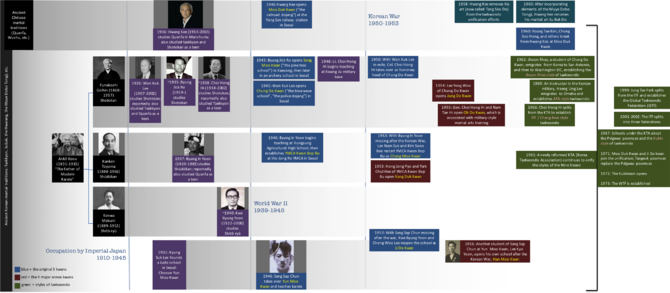The term Traditional Taekwondo (also sometimes called Classic Taekwondo) generally refers to the oldest form of taekwondo, practiced primarily in the 1950s by the South Korean military. This style of taekwondo predates even the name "taekwondo" and really represents an amalgam of martial arts styles practiced then by the Nine Kwans.
Alternative Definitions
- First Definition: The first of the Nine Kwans opened its doors in 1944. The first major international taekwondo federation -- the International Taekwon-do Federation (ITF) -- was founded in 1966. So one could argue that Traditional Taekwondo is taekwondo as it was practiced from 1944 up until the establishment of ITF.
- Second Definition: The name "taekwondo" was not coined however until 1955, so one could argue instead that everything before 1955 was not taekwondo. In this case, the term Traditional Taekwondo would include taekwondo only as it was practiced from 1955 to 1966.
- Third Definition: If, however, one includes ITF/Chang Hon-style Taekwondo under the banner "traditional," then one could argue that Traditional Taekwondo includes ITF-style and all styles that predate ITF.
- Fourth Definition: In the ITF/Chang Hon-style, there are basically two sub-styles: Sine Wave (newer) and non-Sine Wave (older). In ITF circles, the term Traditional Taekwondo is sometimes used to refer to the non-Sine Wave version of the ITF style.
It's generally agreed that any style established after ITF-style is not referred to as traditional. So for example, Kukkiwon-style taekwondo is generally not called "traditional."
Styles
Traditional styles of taewkondo are heavily influenced by karate, combined with elements of Chinese martial arts and traditional Korean martial arts. Depending on the school (kwan), the mixture of these elements varied. For example:
- Early taekwondo pionees such as Won Kuk Lee (of Chung Do Kwan), Byung Jick Ro (of Song Moo Kwan) and Choi Hong Hi (of Oh Do Kwan and ITF) studied Shotokan karate before opening their own schools.
- Byung In Yoon (of YMCA Kwon Bop Bu/Chang Moo Kwan) studied Shūdōkan karate before opening his school.
- Kwe Byung Yoon (of Jidokwan) studied Shitō-ryū karate before opening his school.
- Hwang Kee (of Moo Duk Kwan) is said to have studied primarily Chinese quanfa before opening his school.
Depending on which kwan one studied in then, the style of martial art being studied could be fairly different. Eventually of course these styles were merged to become what we now call taekwondo. (See also: Timeline of Taekwondo.)
Traditional Hyeong (forms)
Many of the forms often used in Traditional Taekwondo are included in the following table. In developing his Moo Duk Kwan curriculum, Hwang Kee assigned symbols, listed below, to many of the forms.
| Family / Origin | Forms |
|---|---|
| Basic beginner forms developed by Hwang Kee in 1947. | |
| Later variants of the beginner forms, developed by the World Tang Soo Do Association; these emphasize earlier training in kicking. |
Sae Kye Hyeong Il Bu |
| Pyung Ahn forms, also called Pinan and Heian forms. From Shotokan Karate, developed approx. 1870 as beginner forms. Symbol: The Tortoise |
Pyung Ahn Cho-Dan |
| Naihanchi forms, from Shotokan Karate. Also called Chul-Gi, Keema, and Tekki. Symbol: The Horse | |
| Bassai forms, Escaping the Fortress, also called Pal-Sek. Adapted into Shotokan Karate but originally from Kung Fu. Symbol: The Cobra |
Bassai Sho |
| Adapted from Shotokan Karate. Symbol: The Crane | |
| From the karate form Kūsankū. Symbol: The Eagle | Kong-Sang-Koon |
| From the karate form Enpi. Symbol: The Bird | Wang Shu (also called Empi) |
| From the karate form Seisan. Symbol: The Preying Mantis | Sei-Shan |
| Ji-On forms, adapted from Shotokan Karate. |
Ji-On, Symbol: The Ram |
| From the karate form Gojūshiho. Symbol: The Tiger |
O Sip Sa Bo (also called Gojūshiho) |
| Adapted by Hwang Kee from Kung Fu and T'ai Chi. | |
| Chil Sung, the Seven Stars developed by Hwang Kee in approx. 1952 |
Chil Sung Il Ro |
| Yook Ro, the Six-Fold Path developed by Hwang Kee in approx. 1958, inspired by the Muye Dobo Tongji. |
Yook Ro Cho Dan - Du Mun |


